One of Morocco’s most interesting and culturally diverse cities is Fez. Fez provides a singular glimpse into the essence of Moroccan heritage and is well-known for its rich traditions and deep historical roots.
Often referred to as Morocco’s “spiritual heart,” Fez is one of the most recognizable and historically significant cities in the nation. Fez was established more than 1,200 years ago and has long been a hub for craftsmanship, education, religion, and culture. It is a must-visit location for tourists looking to connect with Morocco’s heritage more deeply because of its rich history and distinctive personality.
Here are the reasons why tourists from all over the world are still drawn to this historic city.
The Founding of Fez: One of Morocco’s Oldest Imperial Cities
Idris I, the first ruler of the Idrisid dynasty, established Fez at the end of the eighth century, and his son Idris II later expanded it. Because of its advantageous location close to significant rivers and trade routes, the city expanded rapidly. It attracted migrants, academics, traders, and artisans from Tunisia, Sub-Saharan Africa, and Andalusia (present-day Spain). Fez became a cosmopolitan city with solid intellectual and religious underpinnings as a result of this diversity. Later on, it was acknowledged as one of Morocco’s imperial cities, alongside Rabat, Meknes, and Marrakesh.
Eventually, the city divided into two major regions, each established by a distinct immigrant wave, but in the eleventh century, it was united under Almoravid control. This early dual identity is still evident in Fez’s current layout, particularly in its historic medina.
A Spiritual and Cultural Center of the Islamic World
Fez was an important hub for education, spirituality, and culture in the Islamic world over the ages. The city is home to hundreds of mosques, madrasas (Islamic schools), and zawiyas (spiritual lodges), all of which have long been used as hubs for community gatherings, study, and worship.
In addition, Fez was home to prominent Sufi orders and academics, which attracted pilgrims and students from all over North Africa and the Middle East. Many Moroccans still view Fez as the nation’s religious capital. Fez is especially lively during Islamic holidays and festivals, when there is a lot of religious music, spiritual meetings, and traditional processions.
UNESCO World Heritage Status and the Medina of Fez
A UNESCO World Heritage Site designation was given to Fes el-Bali, the old city of Fez, in 1981. It’s among the world’s biggest and most intact medieval cities. The medina is a maze of history with over 9,000 winding streets and alleys where tourists can explore palaces, markets, fountains, caravanserais, and mosques that date back hundreds of years.
The medina’s lack of cars and the fact that everything is carried by handcarts, donkeys, or foot—just as it was hundreds of years ago—are among its most striking characteristics. This distinctive feature gives tourists a genuine sense of the appearance and atmosphere of medieval Islamic cities. With the sounds of artisans, the aroma of leather and spices, and the splendor of traditional Andalusian-Moorish architecture all around, strolling through the medina is like traveling back in time.
The Intellectual Legacy of Al-Qarawiyyin University
The University of Al-Qarawiyyin stands as one of Fez’s most significant contributions to global civilization. UNESCO and the Guinness World Records have officially recognized this institution as the oldest continuously operating university in the world, having been founded in 859 AD by a woman named Fatima al-Fihri.
Al-Qarawiyyin was a center for advanced studies in the fields of theology, law, astronomy, medicine, mathematics, grammar, and philosophy in addition to being a religious school. Scholars from throughout the Muslim world and even Europe were drawn to it during the Middle Ages. The intellectual circles of Fez had some connection to a number of prominent individuals, such as the historian Ibn Khaldun and the Jewish philosopher Maimonides.
Al-Qarawiyyin continues to stand as a testament to the city’s dedication to wisdom, knowledge, and cultural tolerance. Situated in the center of the medina, its stunning mosque and library serve as a living testament to Islamic scholarship.
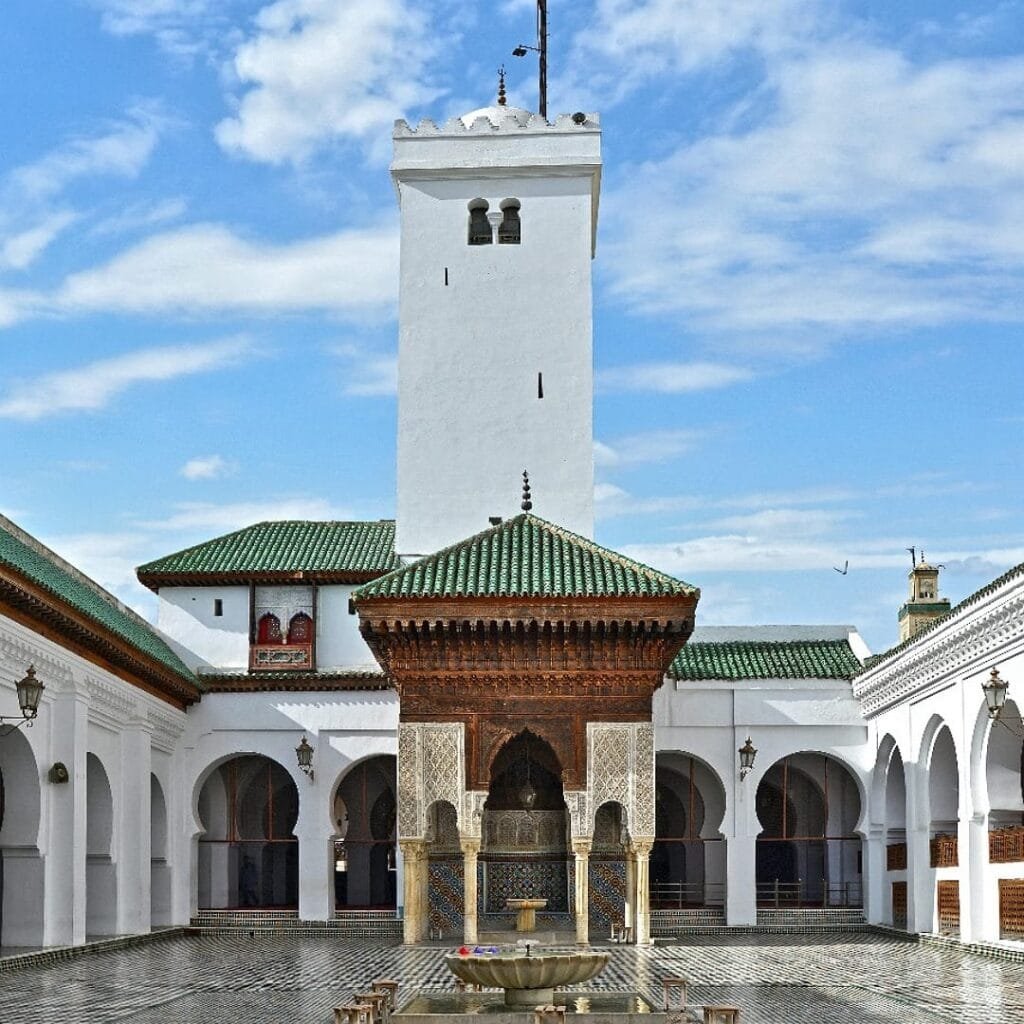


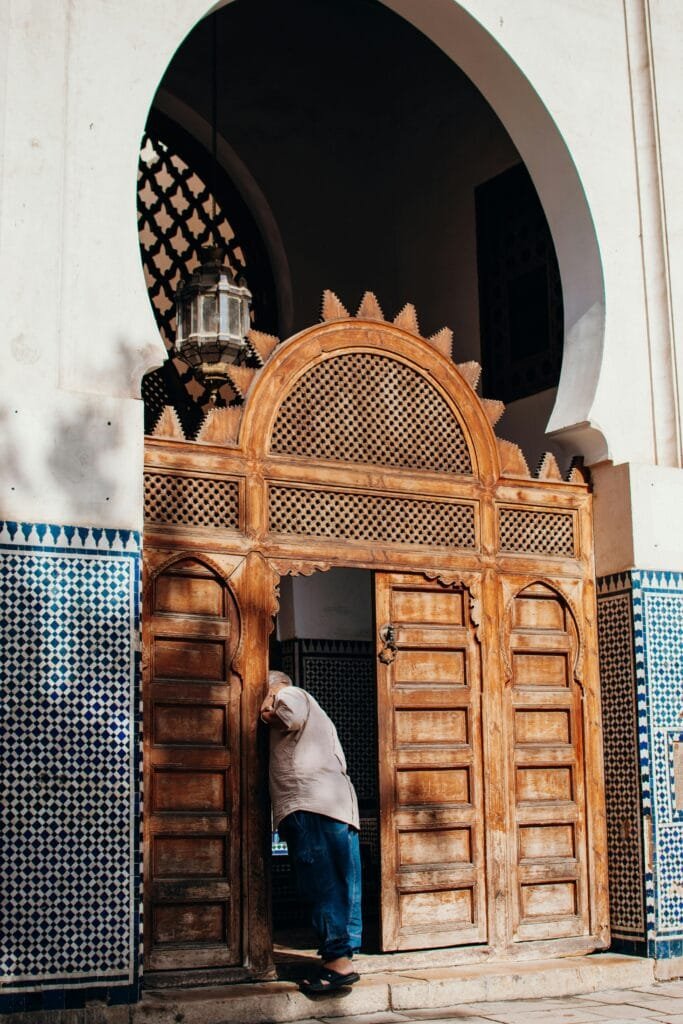

The Remarkable Medina of Fez
It’s like entering a living, breathing time capsule when you enter Fes el-Bali, the medina of Fez. This historic neighborhood is the world’s largest car-free urban area in addition to being the oldest section of the city. Almost completely intact, the medina is a masterwork of medieval Islamic urban planning, with over 9,000 winding alleys and narrow streets.
A World Without Cars
Fes el-Bali is a pedestrian paradise in contrast to contemporary cities where traffic rules day-to-day existence. The medina’s passageways are extremely narrow, with some hardly wide enough for two people to walk side by side, making it impossible for cars to enter. The traditional modes of transportation are hand-pulled carts, donkeys, and foot. As a result, instead of the sound of engines, there is a calm atmosphere filled with the sounds of footsteps, artisans at work, and the call to prayer.
A Maze of More Than 9,000 Streets
Fes el-Bali’s intricate design is among its most intriguing—and occasionally confusing—features. Even the most seasoned tourist can easily become lost in the more than 9,000 alleyways. But that adds to the allure. Unexpected finds like a secret courtyard, a mosaic fountain, or a tiny workshop where craftspeople have been practicing for generations can be found when exploring without a map.
It was no coincidence that this intricate system of pathways existed. It was intended to be both functional and defensive, providing shade, facilitating airflow, and making the city more difficult to invade. This arrangement, which reflects traditional communal life, still controls the temperature and promotes neighborly interaction.
Architectural Gems at Every Turn
There are many magnificent and modest architectural gems throughout the medina. On almost every street, visitors can see elaborate fountains, zellij tilework, and cedarwood doors with intricate carvings. From homes and public ovens to mosques and madrasas, many of these structures are hundreds of years old.
The consistency of the design is among the most striking aspects. The use of traditional Andalusian-Moorish styles creates a visual harmony throughout the medina, despite its size and complexity. The city’s historic architecture is characterized by the careful balancing act between ornamentation and functionality.
A Living Museum of Daily Life
Fes el-Bali is a living medina, in contrast to many other ancient sites that have been abandoned or preserved solely for tourism. It still houses and employs over 150,000 people. Households are passed down through the generations, and craftspeople still make things with methods that haven’t changed since the Middle Ages.
Here, guests experience history rather than merely viewing it. Traditional wood-fired ovens are still used by bakers, clothing is still hand-stitched by tailors in darkened workshops, and metalworkers still hammer copper and brass by hand in resonant souks. Life goes on as usual, providing a unique and genuine window into the cadences of a premodern metropolis.
An Urban Plan Frozen in Time
The medina’s urban structure has largely remained unchanged for centuries, which adds to its remarkable qualities. In its natural layout, which predates contemporary planning, there are mixed-use communities with stores, residences, mosques, and schools coexisting. There is a strong feeling of privacy and community because narrow pathways lead to small public squares or dead ends.
Because of its maintained authenticity, Fes el-Bali is more than just a destination; it’s an immersive experience that both challenges and delights contemporary tourists. It’s about getting lost, interacting with locals, and rediscovering how cities used to live and breathe—not about taking in the sights from afar.
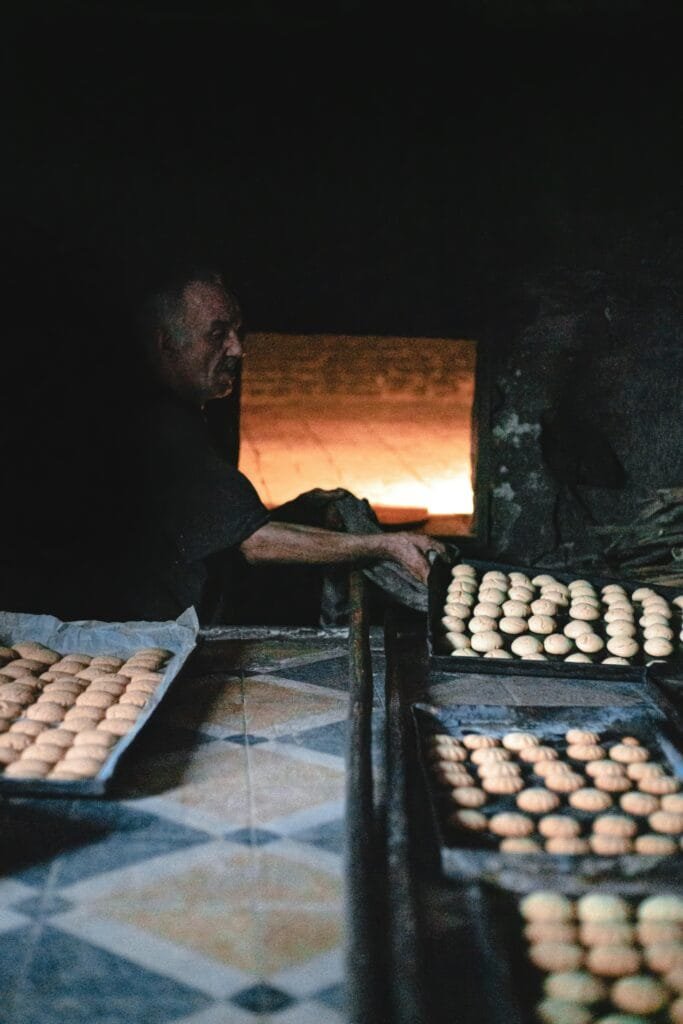
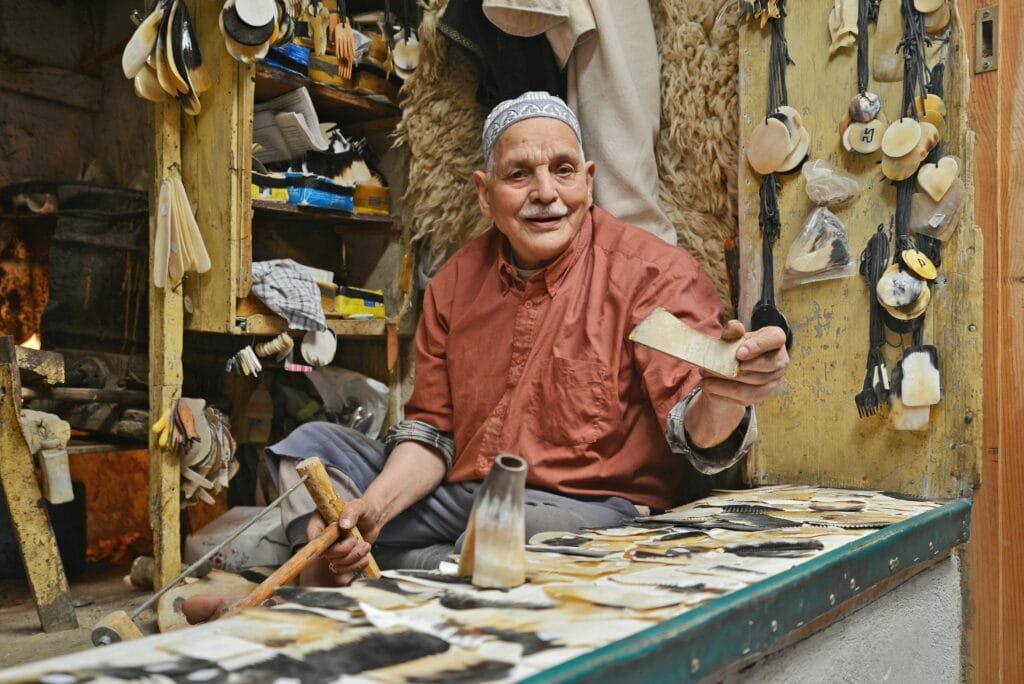

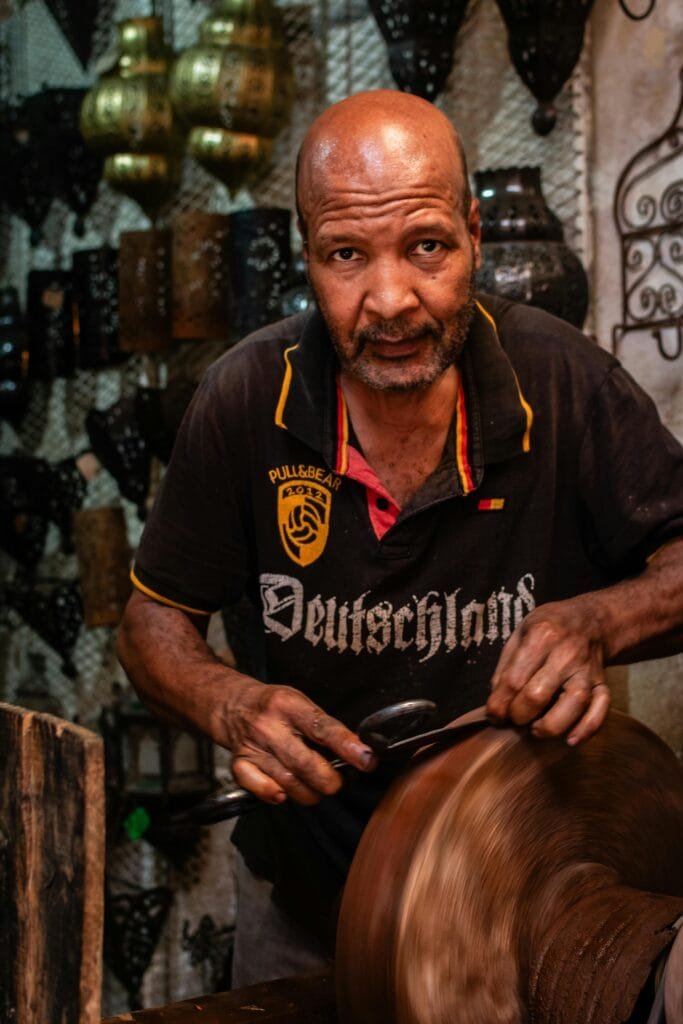

Traditional Craftsmanship and Artisanal Heritage
Fez is a thriving hub for traditional craftsmanship that has been handed down through the ages, in addition to being a city rich in spirituality and history. The sounds, hues, and fragrances of craftspeople using ancient methods in textiles, metalworking, leatherworking, and pottery fill the medina of Fez. Discovering these crafts gives tourists a close-up view of Morocco’s rich artisanal history and the enduring customs that shape the city’s identity.
The Iconic Blue Pottery and Ceramics of Fez
Fez is known throughout the world for its unique blue and white ceramics, which have been made since the tenth century. Their cobalt blue glaze and elaborate hand-painted geometric and floral designs instantly identify these ceramics, which have Andalusian and Middle Eastern influences.
Expert potters use clay from the area to form bowls, plates, tiles, and vases in workshops on the outskirts of the medina. They then hand-decorate them using traditional horsehair brushes. Often in family-run studios that have been in business for decades, visitors can observe the entire process, from the preparation and molding of clay to the glazing and firing. The most well-known ceramic products are the zellij tiles, which are used in Moroccan floors, walls, and fountains and exhibit both artistic flair and mathematical accuracy.
The Ancient Tanneries and Leather Production
The ancient tanneries of Fez, especially the Chouara Tannery, which has been in use since the eleventh century, are among its most famous landmarks. The tannery, as viewed from above, is a beautiful patchwork of stone vats loaded with vivid dyes—yellow, brown, blue, and red—that are used to color hides the old-fashioned way.
Workers standing in the vats are visible to visitors as they manually treat and dye leather using natural materials like saffron, lime, and pigeon droppings. The procedure offers an intriguing look at medieval techniques that are still in use today, despite the overpowering odors.
Fez is known for producing high-quality belts, bags, jackets, and babouches (traditional slippers), all of which are handmade and sold directly in the local souks. The city’s leather is regarded as some of the best in the world.
Intricate Metalwork and Brass Crafting
The metalwork of Fes, particularly in copper and brass, is another gem of its artisanal culture. Visitors can hear the rhythmic hammering of artisans forming metal into trays, teapots, lanterns, and ornamental plates in Seffarine Square, which is close to the Qarawiyyin Mosque. In addition to being useful, these pieces are exquisitely embellished with hand-engraved patterns that reference Moroccan and Islamic art.
A combination of strength, accuracy, and inventiveness are needed for this craft. The majority of artisans continue centuries-old family customs by learning their craft at an early age. Anyone walking by is given a memorable sensory experience by the combination of the warm sounds of the workshop and the glow of the polished brass.
Textile Arts: Embroidery and Weaving
Moreover, Fez is a hub for textile arts, particularly hand-loom weaving and embroidery. The beauty and intricacy of traditional embroidery, or “Tarz Fassi,” are highly praised. Silk threads are used by artisanal (usually female) people to adorn clothing, tablecloths, and cushion covers with intricate designs influenced by geometric symmetry and nature. Depending on the piece, this delicate embroidery may take days or even weeks to finish.
Large wooden looms are used by artisans in neighboring weaving ateliers to create belts, scarves, djellabas, and other traditional garments. The “belt of Fez,” a broad, vibrant silk belt worn at weddings and other special events, is one of the most well-known regional goods.
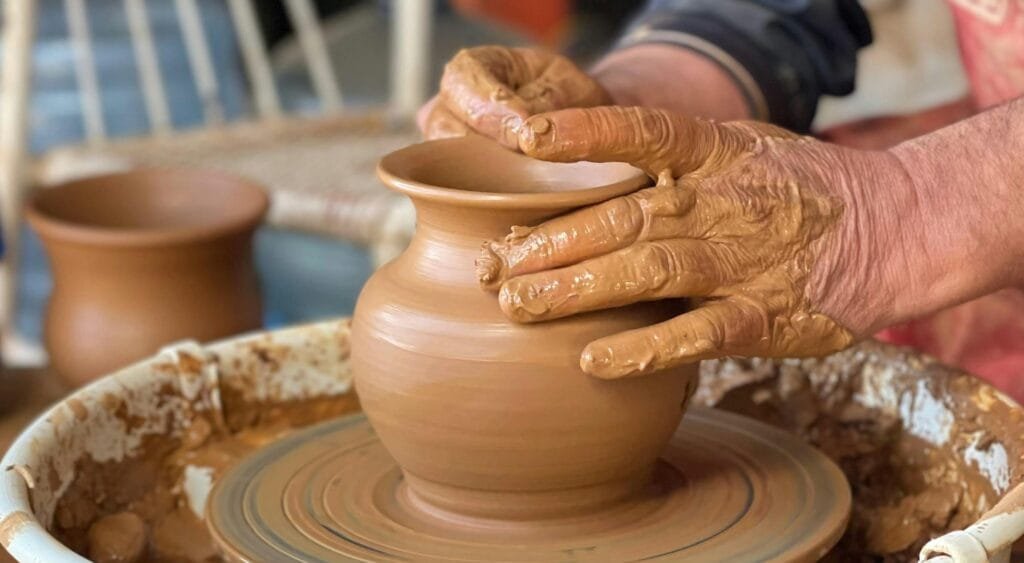
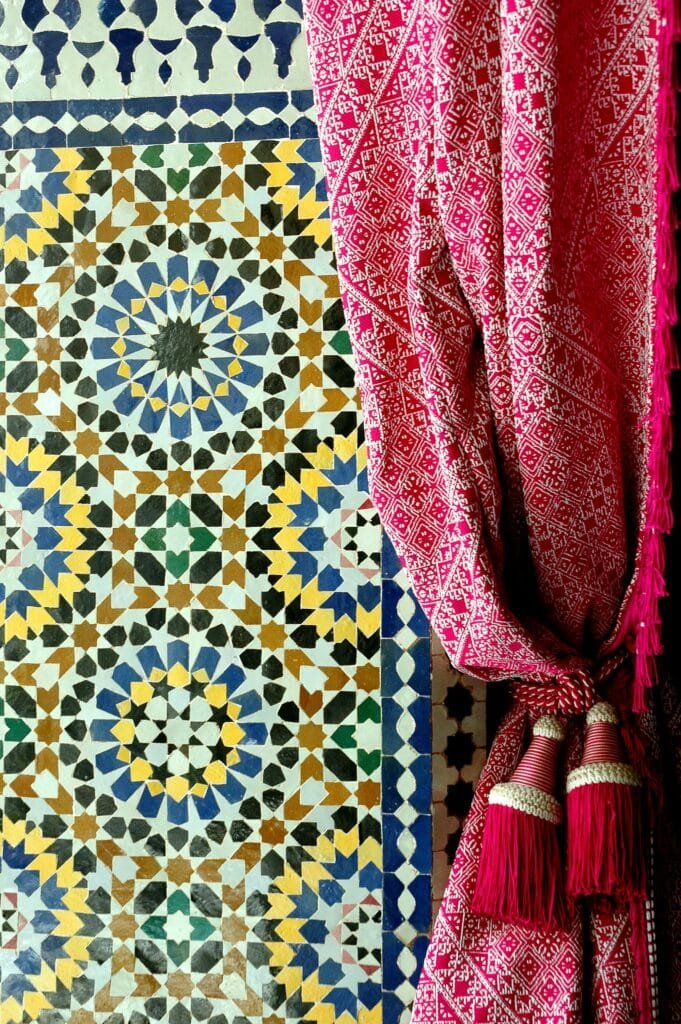
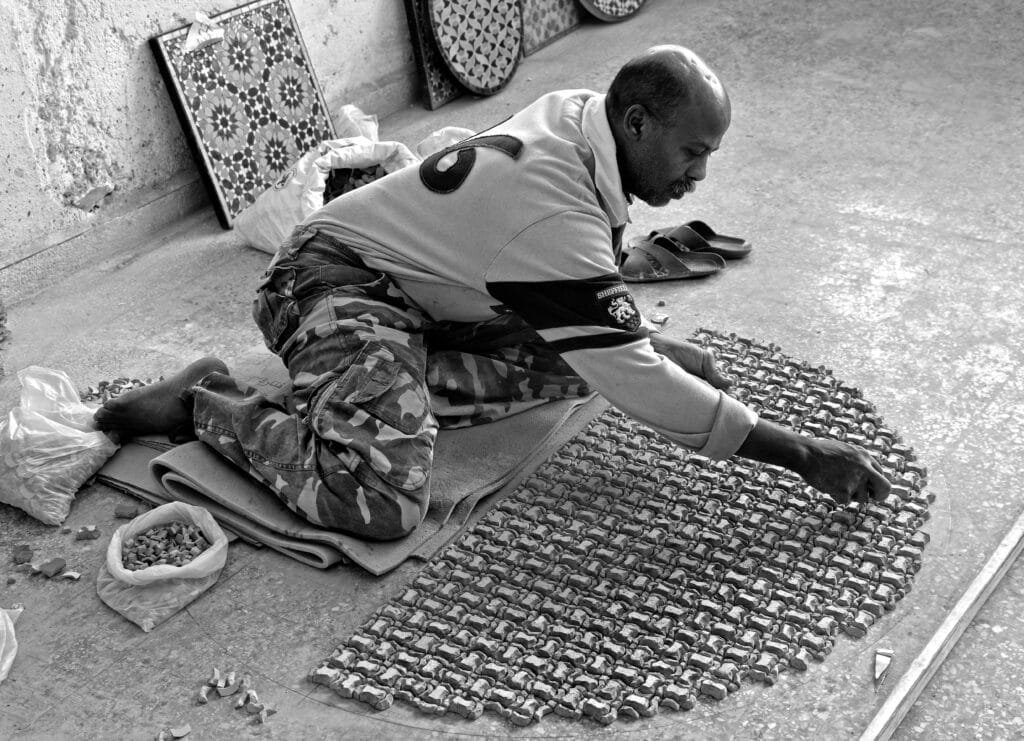
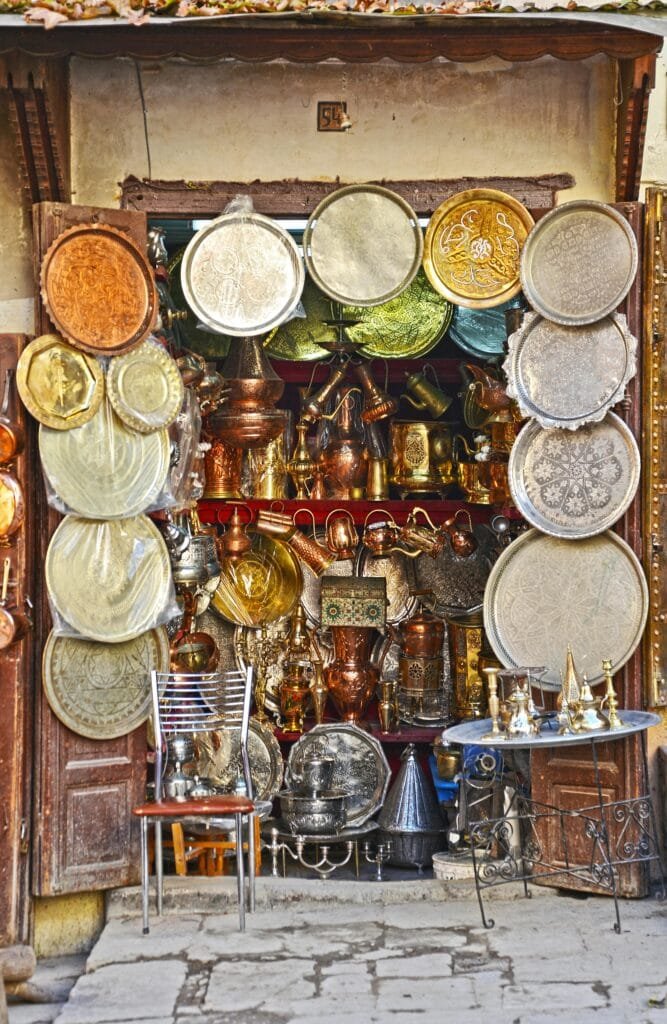
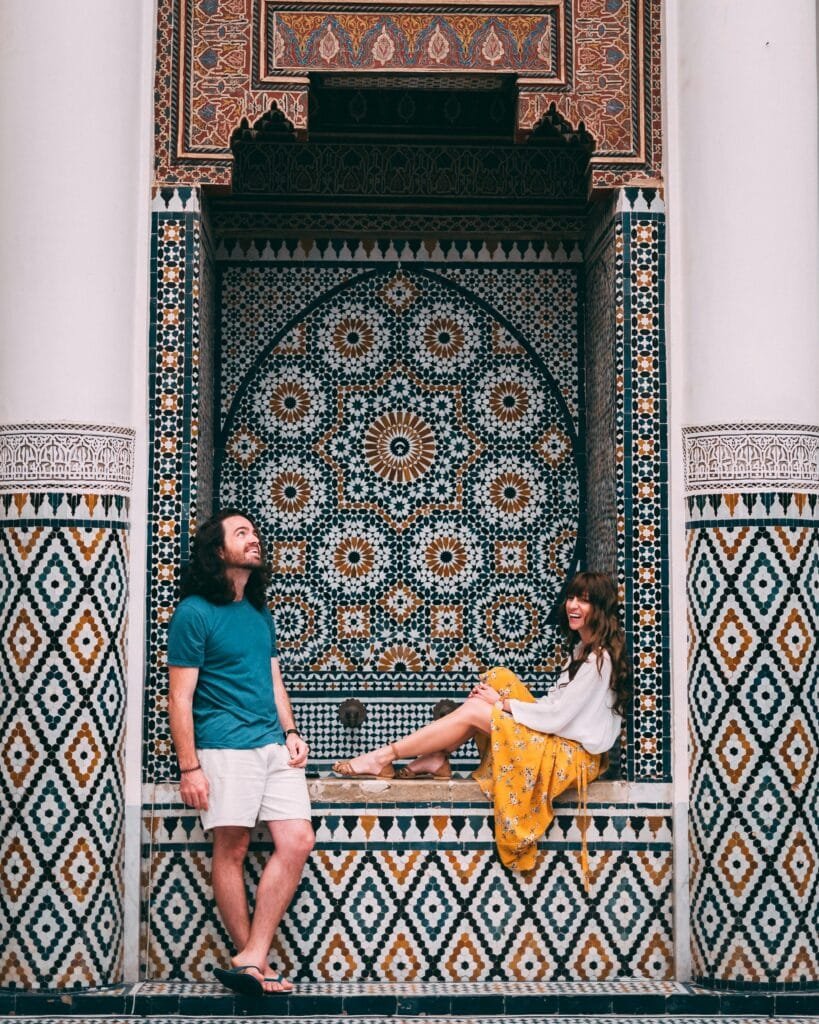
Culinary Traditions That Define Fez
Fez is one of Morocco’s best places to eat in addition to being a center of culture and religion. Fassi cuisine, which has its origins in centuries-old culinary culture and royal customs, is renowned nationwide for its sophistication, nuance, and celebration of flavor. In Fez, dining is more than just a basic need; it’s a ritual, an art form, and a direct link to the city’s illustrious history.
A Royal Legacy of Flavor
Fez’s food has been influenced by the royal family for centuries. The city drew chefs from Andalusia, the Middle East, and sub-Saharan Africa because it was once the home of dynasties and academics. A distinctive fusion of culinary styles was thus produced, with a focus on intricate preparations, nuanced spice combinations, and a balance of savory and sweet components.
In Fez, meals are frequently multi-course affairs that start with vibrant mezze-style salads, progress to hearty main courses, and conclude with seasonal pastries or fruits infused with rose water and orange blossoms. The city’s sophistication and meticulous attention to detail, developed over many generations, are evident in every dish.
Signature Fassi Dishes
Many regional specialties that are uncommon in other parts of Morocco can be found in Fez. One of the most well-known is the Pastilla (also called the Bastilla), a savory-sweet pie that is typically made with chicken or pigeon and is wrapped in delicate warqa pastry and layered with almonds, eggs, cinnamon, and sugar. It is a genuine representation of Fassi culinary sophistication due to the contrast between sweet and salty flavors.
Tfaya Couscous, which is served with caramelized onions, raisins, and cinnamon and frequently paired with tender meat, is another well-known dish. It’s especially well-liked on Fridays and during celebrations.
Mrouzia, a lamb tagine that is slow-cooked and flavored with saffron, honey, raisins, and almonds, is another dish that Fez is famous for. It is typically made for Eid. Every dish is expertly prepared, frequently requiring hours or even days to complete.
The Spice Markets and Food Culture
Explore the spice markets (souks) dotted throughout the medina to get a sense of the depth of Fassi cuisine. Towering piles of cumin, saffron, ginger, cinnamon, paprika, and ras el hanout—a unique mixture of up to 30 spices—can be seen as you pass through these fragrant alleys. The dried flowers, preserved lemons, and hand-ground spices that are all vital components of traditional Moroccan cooking are proudly displayed by the vendors.
Fez has a very communal food culture that goes beyond ingredients. A single large dish is frequently used for meals, which promotes interaction and conversation. Every meal must include bread, which is used to scoop food instead of cutlery. When served liberally throughout the day, mint tea is more than just a beverage; it is a sign of friendliness and acceptance.
Food is a symbol of heritage, identity, and memory in Fez. Visitors are encouraged to experience centuries of history in every bite, whether they are dining in a family-run riad, shopping in the spice souks, or watching a tagine bubble slowly over hot coals.





Modern Fez: Tourism and Cultural Preservation
Fez, one of the most recognizable cities in Morocco, is seeing a boom in travel. However, it stands out for striking a careful balance between embracing tourists and maintaining the authenticity that makes it unique. In addition to being a dynamic city where the past and present coexist peacefully, Fez is now a living museum of medieval life. By means of cultural celebration, continuous restoration, and mindful tourism, Fez keeps evolving while preserving its legacy.
Tourism with Authenticity at Its Core
Travelers looking for more profound and significant experiences are drawn to Fez. Fez provides immersive experiences with local life, unlike cities shaped by mass tourism, whether it’s exploring the medina’s narrow lanes, dining in a centuries-old riad, or visiting craftspeople in their workshops.
Cultural integrity has been given precedence over commercialization by tour operators and local initiatives, which frequently involve locals in the tourism process. Numerous activities are designed to educate as well as to amuse visitors, giving them a better understanding of the city’s culture, customs, and populace.
Restoration Projects: Preserving the Soul of the City
Fez has witnessed a bold surge of conservation and restoration initiatives in recent decades, backed by the Moroccan government as well as global institutions like UNESCO. These initiatives concentrate on utilizing traditional building methods and materials to restore historic monuments, mosques, libraries, and madrasas.
Examples include the meticulous restoration of old wood-carved doors, elaborate zellij tile work, and medieval fountains. In addition to making the city aesthetically pleasing, the objective is to guarantee that Fez’s architectural design, craftsmanship, and cultural traditions are maintained for upcoming generations.
Cultural Festivals Celebrating Fassi Heritage
In addition to being a center of culture, modern Fez hosts numerous festivals and events honoring its rich history. Among the most well-known is the Fez Festival of World Sacred Music, which unites musicians and spiritual performers from all over the world to play in historic venues like palaces, riads, and old gardens.
Other celebrations focus on calligraphy, Sufi poetry, traditional storytelling, and culinary arts. In addition to drawing tourists, these gatherings give residents a renewed sense of pride in their city’s enduring contributions to philosophy, religion, and the arts.
Fez’s Influence on Morocco’s National Identity
Morocco as a whole has been significantly impacted by Fez’s ongoing fame. Fez, the birthplace of numerous Moroccan dynasties and the former capital, symbolizes the core of Moroccan identity. Its spiritual influence, architectural heritage, and intellectual history all continue to influence national pride and culture.
Fez is more than just a city to many Moroccans; it is a symbol. It represents excellence, tradition, and wisdom. Fez serves as a reminder to both locals and tourists that modernity and heritage can coexist peacefully, enhancing one another at every turn as the world rediscovers the city’s treasures.

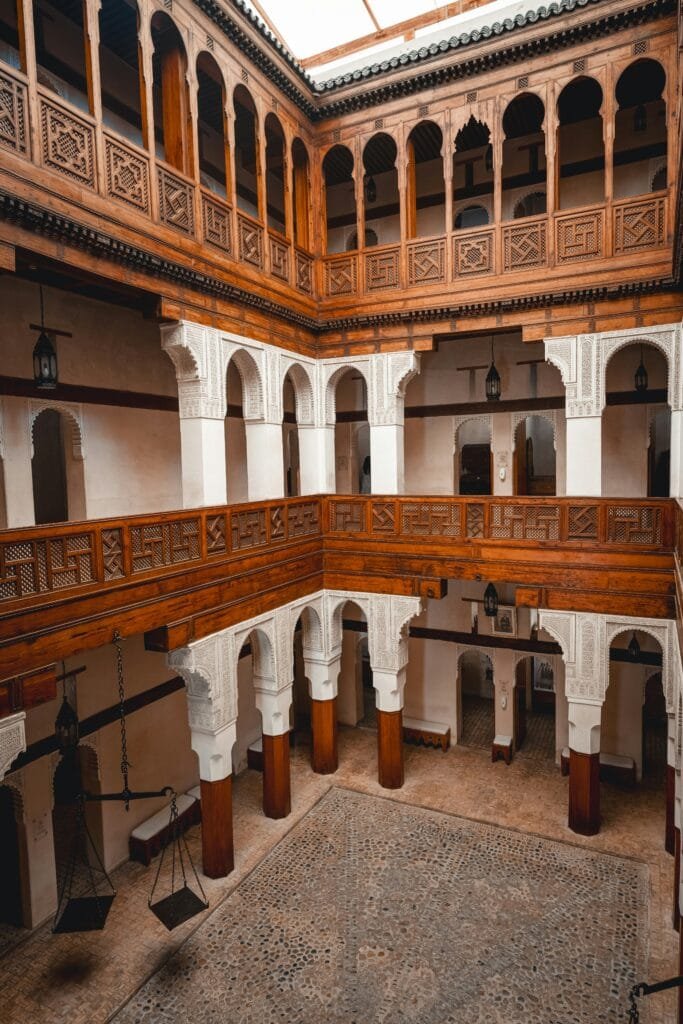

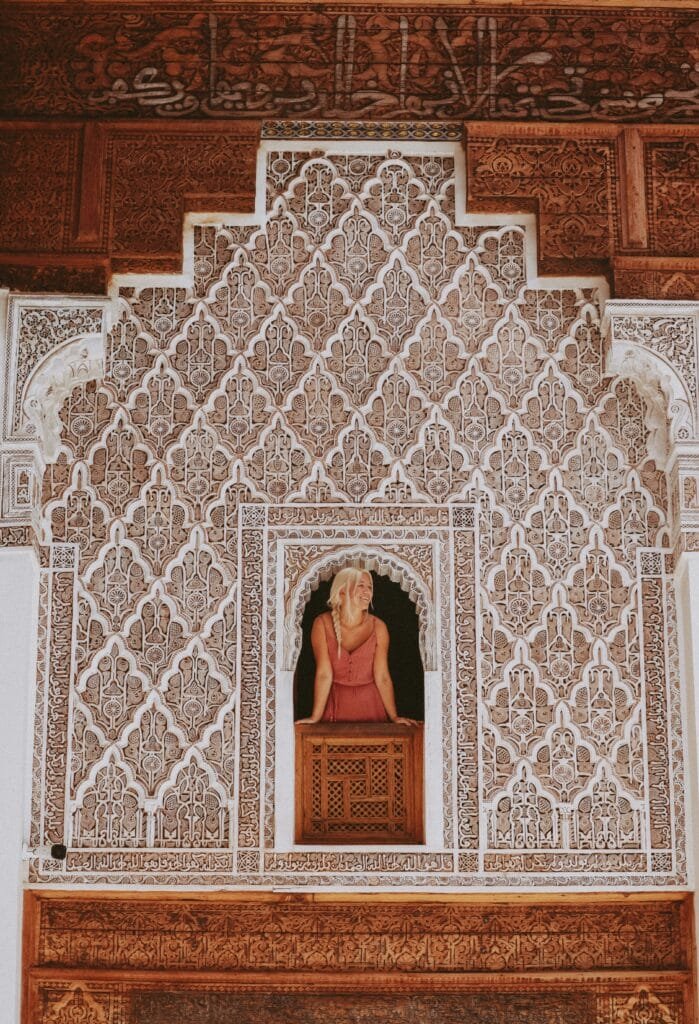
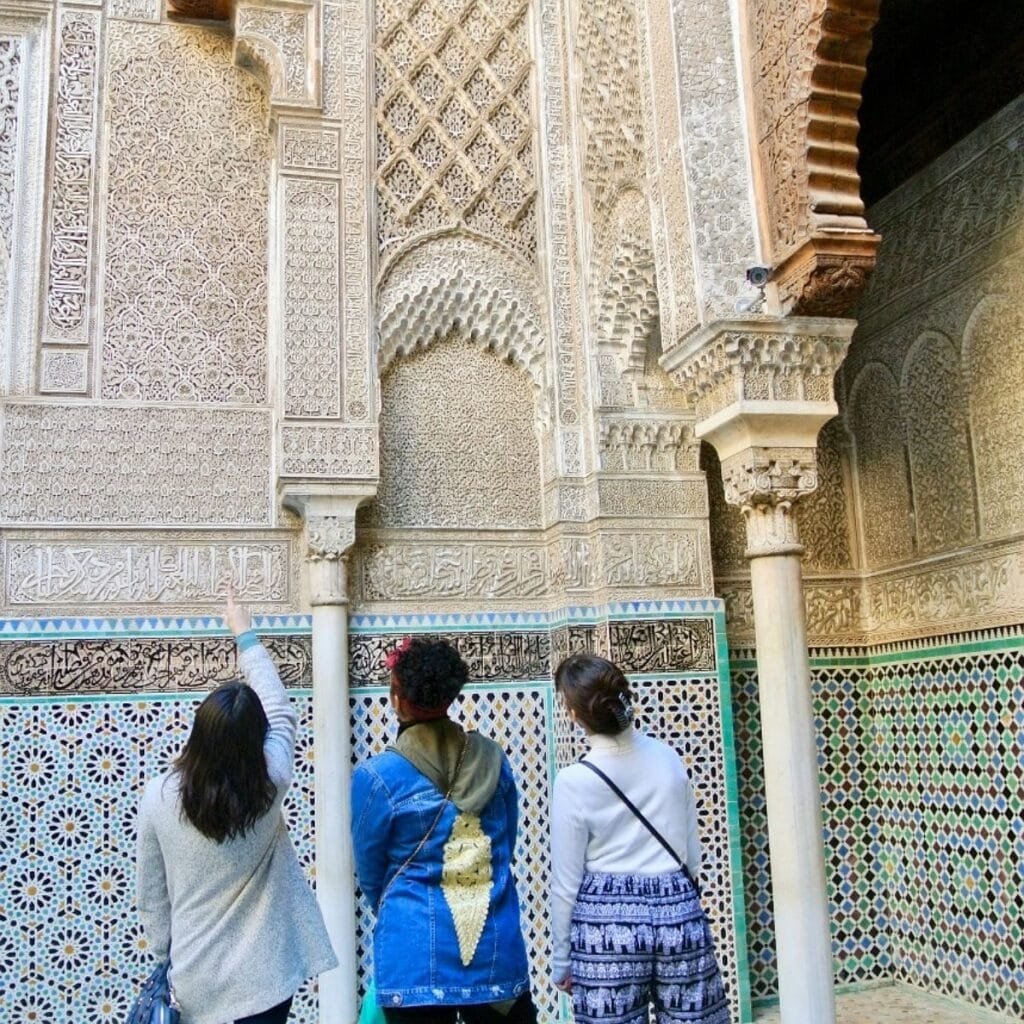

Fez is a city you feel, hear, taste, and remember—it’s more than just a place you visit. Fez provides a timeless trip through Morocco’s heart and history, from its historic medina and sacred customs to its artisanal heritage and exquisite cuisine. Scholars, sultans, and artisans are whispered in every alleyway. The flavor of centuries is present in every dish. And a world preserved in its most pristine state is revealed around every corner.
Fez encourages you to look past the obvious, whether you’re interested in history, want to experience the lively souks, or just want to get a sense of real Moroccan culture.
If you’d like to experience Fez with depth and insight, we invite you to book a guided tour with one of our experienced local experts—or feel free to reach out with any questions. We’re here to help you uncover the hidden beauty and spirit of this unforgettable city.
Let Fez reveal itself to you—one story, one flavor, and one step at a time.

